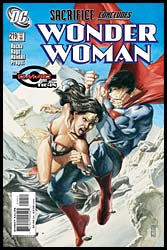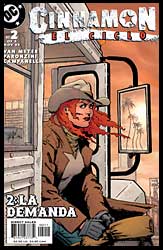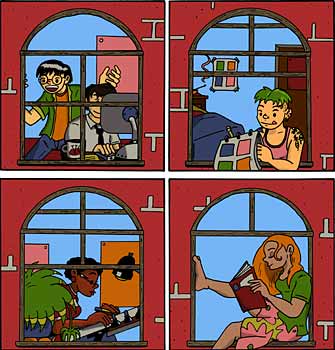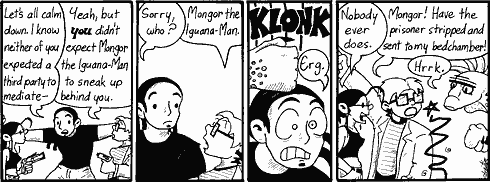Vassar in the Funny Books
If we had childhood ambitions to write or draw comics, most of us abandoned them in elementary school. But five Vassar graduates actually spend part of their days writing, drawing, or editing comics and indulging in the medium they grew up with. They have in common a clear passion for comics but think quite differently about their jobs.
Greg Rucka ’91 was writing fiction full-time and had already published his first book (at the age of 26) when he started writing comics. Since then he has created the espionage series Queen and Country and written Batman, Wolverine, Wonder Woman, and Superman. For Rucka, writing comics requires more than just a shift from thinking textually to thinking visually.
It’s important to think of prose and comics as separate media with their own rules and limitations, he says. One of the benefits of working in comics is the medium’s ability to play with time. “It’s possible to break it down, stretch it out, and accelerate it all in the course of two or three panels. If you do that in prose, you’re going to give the reader a headache. You either need to be James Joyce—and most of us aren’t—or else you’re spending an awful lot of work trying to accomplish the same goal and probably to less effect.”
Another difference is that comics writing is always dictated by issues of economy. “I like to think of it as playing a game of chess. You have only 22 pages, and you have to fill those 22 pages with a number of panels. There are a finite number of moves. There may be ten to the fifteenth power of moves, but it’s a finite amount.”

“You make a trade-off,” he says. “You get to work for Time Warner AOL [which owns DC Comics], and you can take this toy and have fun with it; but there are rules: don’t break them. Don’t do anything to this toy that makes it unusable for others. That’s the essence of work for hire. I get to write stuff that Batman says, which is pretty cool, but at the end of the day I don’t own it. And that’s all right.”
For Nunzio DeFilippis ’91 and Christina Weir ’92, a married writing team who have written extensively for television and video games, the grammar of a comic script is very similar to screenwriting, but with some differences. One, DeFilippis argues, is that in comics the writer gets to “direct” the action, laying out how the panels and pages should look, dictating a lot of the look and design of the book.
The bigger trick, he and Weir say, has been getting used to thinking in terms of pacing a comic. “If you’re writing a screenplay, and a scene ends on page 10 or 11, it’s not that relevant,” Weir said. “With a comic book you want to plot toward where the page turn is so that you have a certain image at the end of one page before you flip to the next; so you have to be a lot more precise in terms of how you pace it out.”

It may be a lot of fun, but there’s also a great deal of planning involved. “We know how many issues it’s going to take and what we want to cover in each issue,” Weir said. “Then we break it down page by page and figure, this scene will take ten pages, this will be one page, and we make sure we have that all laid out before we start writing.”
DeFilippis says comics is a constantly evolving field. “If you look at old comics, some of them aren’t written all that well. There are devices used in comics that are clich�—thought balloons for one—that comics readers love. Thought balloons are literally getting inside someone’s head, and that’s kind of a cheat, something you don’t often see in, say, novels. Chris Claremont in the old X-Men books was able to condense a lot of character into one issue because you were in a character’s head. If there was a love triangle, all you needed was a thought balloon saying, ‘I can’t decide between so and so and so and so.’ Boom. You’ve laid out a love triangle in one panel. That’s one piece of the process that’s falling out of favor. But there’s still a huge chunk of the audience that’s constantly asking, ‘Where are the thought balloons?’ because it gave them a cheap out.”

When Jen Van Meter ’90 started writing comics she created a series of analogies between comics and the literary forms she had a better vocabulary for and understanding of. “I think of the page limit much like a limit in lines. Like a 22-line sonnet where everything has to be controlled in some way.

Van Meter, who’s working on Buffy the Vampire Slayer, the Blair Witch Project, Batman, and the Justice Society of America, is best known for writing the series Hopeless Savages, a family comedy about the children of two punk musicians.
“It’s taking the notion of a conventional family and examining the extent to which everyone is conventional behind closed doors and the extent to which nobody is,” Van meter explains. “One of the things I think sitcoms do is keep the characters the same over time. In the family comedy especially, from The Dick Van Dyke Show to something more contemporary, there’s still this notion that from week to week the family doesn’t change. I wanted instead to work with the idea of a family comedy that was about people changing over time.”
Shaenon Garrity '00 drew comics for the Cleveland Plain Dealer in high school and drew The Ratio in the Miscellany News for four years at Vassar. Since graduation she has been writing and drawing the daily comic strip Narbonic, which has been collected into two volumes so far. "I was getting ready to graduate and was sorry because I didn't have an excuse to keep drawing the comic strip," Garrity says." About that time my friend introduced me to Web comics, and it looked like a pretty easy way to keep drawing. That was the entire extent of my thinking there.

"My whole idea of comics is very heavily influenced by the classes I took at Vassar with Michael Joyce," Garrity says, citing her freshman English class, which focused on hypertext as especially important. "I think that's when I started getting serious about the problem of 'blending word and image,' which is a very naughty and highfalutin way to talk about the comic strip.
"It's been something I've had to learn gradually because I'm more word-oriented than image- oriented. I've been trying to make the pictures carry the story a lot more than I used to, but it's hard." Garrity compares the comic strip to a form like haiku. "It's extremely limited and limiting, having very little space to produce something, and I enjoy that challenge. It's also fun in the way it encourages interaction with readers, because it's part of their daily routine."

Garrity has also created and written comics for other artists that have appeared on moderntales.com, serializer.net, and girlamatic.com. "One thing I like about both writing and drawing a comic strip is that it comes out as solely my vision. When you have an artist draw it, it ends up as a collaboration because it's always going to have the artist's influence and thought process in it no matter how carefully you script it out. I like working with an artist, having that gestalt of ideas and viewpoints; but I also like having one thing that's entirely mine."
Looking ahead, Garrity plans to end Narbonic in less than two years, when she's completed its set story line; but she has few definite plans other than wanting to make more comics. "I do have a real job that pays money, so I'm not terrifically concerned about my comics career per se. At present I'm happy really just to keep drawing what I'm drawing right now and let things work out as they may."
Dueben '01 lives and works in Los Angeles.
